Exogenously Applied Cytokinin Altered the Bacterial Release and Subsequent Stages of Nodule Development in Pea Ipd3/Cyclops Mutant
Abstract
1. Introduction
2. Results and Discussion
2.1. The Influence of Cytokinin on Morphology and Ultrastructure of Nodules in Pea Sym33-3 Mutant
2.2. Cytokinin Influences the Growth of Infection Threads and Bacterial Release in Nodules of Sym33-3 Mutant
2.3. Changes in the Expression of Genes Related to Bacterial Release, Accommodation and Subsequent Bacteroid Differentiation Induced by Cytokinin in Sym33 Mutant
2.4. Analysis of Cytokinin Influence on Regulation of Nodule Morphogenesis
2.5. Conclusions
3. Materials and Methods
3.1. Bacterial Strains and Inoculation
3.2. Plant Material and Growth Conditions
3.3. Material Fixation and Staining of Sections
3.4. Transmission Electron Microscopy
3.5. Isolation of RNA and Quantitative Reverse Transcription PCR (qRT-PCR)
3.6. Searching Homologues of Known Genes and Their Analysis
3.7. Phylogenetic Analysis
3.8. Statistical Analysis
Supplementary Materials
Author Contributions
Funding
Institutional Review Board Statement
Informed Consent Statement
Data Availability Statement
Acknowledgments
Conflicts of Interest
References
- Gamas, P.; Brault, M.; Jardinaud, M.F.; Frugier, F. Cytokinins in Symbiotic Nodulation: When, Where, What For? Trends Plant Sci. 2017, 22, 792–802. [Google Scholar] [CrossRef] [PubMed]
- Foo, E.; Plett, J.M.; Lopez-Raez, J.A.; Reid, D. Editorial: The Role of Plant Hormones in Plant-Microbe Symbioses. Front. Plant Sci. 2019, 10, 1391. [Google Scholar] [CrossRef] [PubMed]
- Lin, J.; Roswanjaya, Y.P.; Kohlen, W.; Stougaard, J.; Reid, D. Nitrate Restricts Nodule Organogenesis through Inhibition of Cytokinin Biosynthesis in Lotus Japonicus. Nat. Commun. 2021, 12, 6544. [Google Scholar] [CrossRef] [PubMed]
- Gonzalez-Rizzo, S.; Crespi, M.; Frugier, F. The Medicago Truncatula CRE1 Cytokinin Receptor Regulates Lateral Root Development and Early Symbiotic Interaction with Sinorhizobium Meliloti. Plant Cell 2006, 18, 2680–2693. [Google Scholar] [CrossRef]
- Van Zeijl, A.; Op Den Camp, R.H.M.; Deinum, E.E.; Charnikhova, T.; Franssen, H.; Op Den Camp, H.J.M.; Bouwmeester, H.; Kohlen, W.; Bisseling, T.; Geurts, R. Rhizobium Lipo-Chitooligosaccharide Signaling Triggers Accumulation of Cytokinins in Medicago Truncatula Roots. Mol. Plant 2015, 8, 1213–1226. [Google Scholar] [CrossRef]
- Liu, J.; Rutten, L.; Limpens, E.; van der Molen, T.; van Velzen, R.; Chen, R.; Chen, Y.; Geurts, R.; Kohlen, W.; Kulikova, O.; et al. A Remote Cis -Regulatory Region Is Required for NIN Expression in the Pericycle to Initiate Nodule Primordium Formation in Medicago Truncatula. Plant Cell 2019, 31, 68–83. [Google Scholar] [CrossRef]
- Triozzi, P.M.; Irving, T.B.; Schmidt, H.W.; Keyser, Z.P.; Chakraborty, S.; Balmant, K.; Pereira, W.J.; Dervinis, C.; Mysore, K.S.; Wen, J.; et al. Spatiotemporal Cytokinin Response Imaging and ISOPENTENYLTRANSFERASE 3 Function in Medicago Nodule Development. Plant Physiol. 2021, 188, 560–575. [Google Scholar] [CrossRef]
- Reid, D.E.; Nadzieja, M.; Novak, O.; Heckmann, A.B.; Sandal, N.; Stougaard, J. Cytokinin Biosynthesis Promotes Cortical Cell Responses during Nodule Development. Plant Physiol. 2017, 175, 361–375. [Google Scholar] [CrossRef]
- Murray, J.D.; Karas, B.J.; Sato, S.; Tabata, S.; Amyot, L.; Szczyglowski, K. A Cytokinin Perception Mutant Colonized by Rhizobium in the Absence of Nodule Organogenesis. Science 2007, 315, 101–104. [Google Scholar] [CrossRef]
- Tirichine, L.; Sandal, N.; Madsen, L.H.; Radutoiu, S.; Albrektsen, A.S.; Sato, S.; Asamizu, E.; Tabata, S.; Stougaard, J. A Gain-of-Function Mutation in a Cytokinin Receptor Triggers Spontaneous Root Nodule Organogenesis. Science 2007, 315, 104–107. [Google Scholar] [CrossRef]
- Jardinaud, M.-F.; Boivin, S.; Rodde, N.; Catrice, O.; Kisiala, A.; Lepage, A.; Moreau, S.; Roux, B.; Cottret, L.; Sallet, E.; et al. A Laser Dissection-RNAseq Analysis Highlights the Activation of Cytokinin Pathways by Nod Factors in the Medicago Truncatula Root Epidermis. Plant Physiol. 2016, 171, 2256–2276. [Google Scholar] [CrossRef]
- Plet, J.; Wasson, A.; Ariel, F.; Le Signor, C.; Baker, D.; Mathesius, U.; Crespi, M.; Frugier, F. MtCRE1-Dependent Cytokinin Signaling Integrates Bacterial and Plant Cues to Coordinate Symbiotic Nodule Organogenesis in Medicago Truncatula. Plant J. 2011, 65, 622–633. [Google Scholar] [CrossRef]
- Suzaki, T.; Yano, K.; Ito, M.; Umehara, Y.; Suganuma, N.; Kawaguchi, M. Positive and Negative Regulation of Cortical Cell Division during Root Nodule Development in Lotus Japonicus Is Accompanied by Auxin Response. Development 2012, 139, 3997–4006. [Google Scholar] [CrossRef]
- Breakspear, A.; Liu, C.; Roy, S.; Stacey, N.; Rogers, C.; Trick, M.; Morieri, G.; Mysore, K.S.; Wen, J.; Oldroyd, G.E.D.; et al. The Root Hair “Infectome” of Medicago Truncatula Uncovers Changes in Cell Cycle Genes and Reveals a Requirement for Auxin Signaling in Rhizobial Infection. Plant Cell Online 2014, 26, 4680–4701. [Google Scholar] [CrossRef]
- Ng, J.L.P.; Hassan, S.; Truong, T.T.; Hocart, C.H.; Laffont, C.; Frugier, F.; Mathesius, U. Flavonoids and Auxin Transport Inhibitors Rescue Symbiotic Nodulation in the Medicago Truncatula Cytokinin Perception Mutant Cre1. Plant Cell 2015, 27, 2210–2226. [Google Scholar] [CrossRef]
- Schiessl, K.; Lilley, J.L.S.; Lee, T.; Tamvakis, I.; Kohlen, W.; Bailey, P.C.; Thomas, A.; Luptak, J.; Ramakrishnan, K.; Carpenter, M.D.; et al. NODULE INCEPTION Recruits the Lateral Root Developmental Program for Symbiotic Nodule Organogenesis in Medicago Truncatula. Curr. Biol. 2019, 29, 3657–3668. [Google Scholar] [CrossRef]
- Mathesius, U.; Schlaman, H.R.M.; Spaink, H.P.; Sautter, C.; Rolfe, B.G.; Djordjevic, M.A. Auxin Transport Inhibition Precedes Root Nodule Formation in White Clover Roots and Is Regulated by Flavonoids and Derivatives of Chitin Oligosaccharides. Plant J. 1998, 14, 23–34. [Google Scholar] [CrossRef]
- Boot, K.J.M.; van Brussel, A.A.N.; Tak, T.; Spaink, H.P.; Kijne, J.W. Lipochitin Oligosaccharides from Rhizobium Leguminosarum Bv. Viciae Reduce Auxin Transport Capacity in Vicia Sativa Subsp. Nigra Roots. Mol. Plant-Microbe Interact. 1999, 12, 839–844. [Google Scholar] [CrossRef]
- Pacios-Bras, C.; Schlaman, H.R.M.; Boot, K.; Admiraal, P.; Langerak, J.M.; Stougaard, J.; Spaink, H.P. Auxin Distribution in Lotus Japonicus during Root Nodule Development. Plant Mol. Biol. 2003, 52, 1169–1180. [Google Scholar] [CrossRef]
- Huo, X.; Schnabel, E.; Hughes, K.; Frugoli, J. RNAi Phenotypes and the Localization of a Protein::GUS Fusion Imply a Role for Medicago Truncatula PIN Genes in Nodulation. J. Plant Growth Regul. 2006, 25, 156–165. [Google Scholar] [CrossRef]
- Rightmyer, A.P.; Long, S.R. Pseudonodule Formation by Wild-Type and Symbiotic Mutant Medicago Truncatula in Response to Auxin Transport Inhibitors. Mol. Plant-Microbe Interact. 2011, 24, 1372–1384. [Google Scholar] [CrossRef] [PubMed]
- Xiao, T.T.; Schilderink, S.; Moling, S.; Deinum, E.E.; Kondorosi, E.; Franssen, H.; Kulikova, O.; Niebel, A.; Bisseling, T. Fate Map of Medicago Truncatula Root Nodules. Development 2014, 141, 3517–3528. [Google Scholar] [CrossRef] [PubMed]
- Mergaert, P.; Uchiumi, T.; Alunni, B.; Evanno, G.; Cheron, A.; Catrice, O.; Mausset, A.E.; Barloy-Hubler, F.; Galibert, F.; Kondorosi, A.; et al. Eukaryotic Control on Bacterial Cell Cycle and Differentiation in the Rhizobium-Legume Symbiosis. Proc. Natl. Acad. Sci. USA 2006, 103, 5230–5235. [Google Scholar] [CrossRef]
- Cebolla, A.; Vinardell, J.M.; Kiss, E.; Oláh, B.; Roudier, F.; Kondorosi, A.; Kondorosi, E. The Mitotic Inhibitor Ccs52 Is Required for Endoreduplication and Ploidy-Dependent Cell Enlargement in Plants. EMBO J. 1999, 18, 4476–4484. [Google Scholar] [CrossRef] [PubMed]
- Yoon, H.J.; Hossain, M.S.; Held, M.; Hou, H.; Kehl, M.; Tromas, A.; Sato, S.; Tabata, S.; Andersen, S.U.; Stougaard, J.; et al. Lotus Japonicus SUNERGOS1 Encodes a Predicted Subunit A of a DNA Topoisomerase VI That Is Required for Nodule Differentiation and Accommodation of Rhizobial Infection. Plant J. 2014, 78, 811–821. [Google Scholar] [CrossRef]
- Suzaki, T.; Ito, M.; Yoro, E.; Sato, S.; Hirakawa, H.; Takeda, N.; Kawaguchi, M. Endoreduplication-Mediated Initiation of Symbiotic Organ Development in Lotus Japonicus. Development 2014, 141, 2441–2445. [Google Scholar] [CrossRef]
- Combier, J.P.; Frugier, F.; De Billy, F.; Boualem, A.; El-Yahyaoui, F.; Moreau, S.; Vernié, T.; Ott, T.; Gamas, P.; Crespi, M.; et al. MtHAP2-1 Is a Key Transcriptional Regulator of Symbiotic Nodule Development Regulated by MicroRNA169 in Medicago Truncatula. Genes Dev. 2006, 20, 3084–3088. [Google Scholar] [CrossRef]
- Laporte, P.; Lepage, A.; Fournier, J.; Catrice, O.; Moreau, S.; Jardinaud, M.F.; Mun, J.H.; Larrainzar, E.; Cook, D.R.; Gamas, P.; et al. The CCAAT Box-Binding Transcription Factor NF-YA1 Controls Rhizobial Infection. J. Exp. Bot. 2014, 65, 481–494. [Google Scholar] [CrossRef]
- Yano, K.; Yoshida, S.; Muller, J.; Singh, S.; Banba, M.; Vickers, K.; Markmann, K.; White, C.; Schuller, B.; Sato, S.; et al. CYCLOPS, a Mediator of Symbiotic Intracellular Accommodation. Proc. Natl. Acad. Sci. USA 2008, 105, 20540–20545. [Google Scholar] [CrossRef]
- Voroshilova, V.A.; Demchenko, K.N.; Brewin, N.J.; Borisov, A.Y.; Tikhonovich, I.A. Initiation of a Legume Nodule with an Indeterminate Meristem Involves Proliferating Host Cells That Harbour Infection Threads. New Phytol. 2009, 181, 913–923. [Google Scholar] [CrossRef]
- Horváth, B.; Yeun, L.H.; Domonkos, Á.; Halász, G.; Gobbato, E.; Ayaydin, F.; Miró, K.; Hirsch, S.; Sun, J.; Tadege, M.; et al. Medicago Truncatula IPD3 Is a Member of the Common Symbiotic Signaling Pathway Required for Rhizobial and Mycorrhizal Symbioses. Mol. Plant-Microbe Interact. 2011, 24, 1345–1358. [Google Scholar] [CrossRef]
- Ovchinnikova, E.; Journet, E.P.; Chabaud, M.; Cosson, V.; Ratet, P.; Duc, G.; Fedorova, E.; Liu, W.; Op Den Camp, R.; Zhukov, V.; et al. IPD3 Controls the Formation of Nitrogen-Fixing Symbiosomes in Pea and Medicago Spp. Mol. Plant-Microbe Interact. 2011, 24, 1333–1344. [Google Scholar] [CrossRef]
- Singh, S.; Katzer, K.; Lambert, J.; Cerri, M.; Parniske, M. CYCLOPS, A DNA-Binding Transcriptional Activator, Orchestrates Symbiotic Root Nodule Development. Cell Host Microbe 2014, 15, 139–152. [Google Scholar] [CrossRef] [PubMed]
- Tsyganov, V.E.; Morzhina, E.V.; Stefanov, S.Y.; Borisov, A.Y.; Lebsky, V.K.; Tikhonovich, I.A. The Pea (Pisum Sativum L.) Genes Sym33 and Sym40 Control Infection Thread Formation and Root Nodule Function. Mol. Gen. Genet. MGG 1998, 259, 491–503. [Google Scholar] [CrossRef]
- Dolgikh, E.A.; Kusakin, P.G.; Kitaeva, A.B.; Tsyganova, A.V.; Kirienko, A.N.; Leppyanen, I.V.; Dolgikh, A.V.; Ilina, E.L.; Demchenko, K.N.; Tikhonovich, I.A.; et al. Mutational Analysis Indicates That Abnormalities in Rhizobial Infection and Subsequent Plant Cell and Bacteroid Differentiation in Pea (Pisum Sativum) Nodules Coincide with Abnormal Cytokinin Responses and Localization. Ann. Bot. 2020, 125, 905–923. [Google Scholar] [CrossRef]
- Rudaya, E.S.; Kozyulina, P.Y.; Pavlova, O.A.; Dolgikh, A.V.; Ivanova, A.N.; Dolgikh, E.A. Regulation of the Later Stages of Nodulation Stimulated by IPD3/CYCLOPS Transcription Factor and Cytokinin in Pea Pisum Sativum L. Plants 2022, 11, 56. [Google Scholar] [CrossRef]
- Vasse, J.; de Billy, F.; Camut, S.; Truchet, G. Correlation between Ultrastructural Differentiation of Bacteroids and Nitrogen Fixation in Alfalfa Nodules. J. Bacteriol. 1990, 172, 4295–4306. [Google Scholar] [CrossRef]
- Lefebvre, B.; Timmers, T.; Mbengue, M.; Moreau, S.; Hervé, C.; Tóth, K.; Bittencourt-Silvestre, J.; Klaus, D.; Deslandes, L.; Godiard, L.; et al. A Remorin Protein Interacts with Symbiotic Receptors and Regulates Bacterial Infection. Proc. Natl. Acad. Sci. USA 2010, 107, 2343–2348. [Google Scholar] [CrossRef]
- Sinharoy, S.; Torres-Jerez, I.; Bandyopadhyay, K.; Kereszt, A.; Pislariu, C.I.; Nakashima, J.; Benedito, V.A.; Kondorosi, E.; Udvardi, M.K. The C2H2 Transcription Factor Regulator of Symbiosome Differentiation Represses Transcription of the Secretory Pathway Gene VAMP721a and Promotes Symbiosome Development in Medicago Truncatula. Plant Cell 2013, 25, 3584–3601. [Google Scholar] [CrossRef]
- Berrabah, F.; Ratet, P.; Gourion, B. Multiple Steps Control Immunity during the Intracellular Accommodation of Rhizobia. J. Exp. Bot. 2015, 66, 1977–1985. [Google Scholar] [CrossRef]
- Bourcy, M.; Brocard, L.; Pislariu, C.I.; Cosson, V.; Mergaert, P.; Tadege, M.; Mysore, K.S.; Udvardi, M.K.; Gourion, B.; Ratet, P. Medicago Truncatula DNF2 Is a PI-PLC-XD-Containing Protein Required for Bacteroid Persistence and Prevention of Nodule Early Senescence and Defense-like Reactions. New Phytol. 2013, 197, 1250–1261. [Google Scholar] [CrossRef] [PubMed]
- Berrabah, F.; Bourcy, M.; Cayrel, A.; Eschstruth, A.; Mondy, S.; Ratet, P.; Gourion, B. Growth Conditions Determine the DNF2 Requirement for Symbiosis. PLoS ONE 2014, 9, e91866. [Google Scholar] [CrossRef] [PubMed]
- Memon, A.R.; Schwager, C.K.; Niehaus, K. Expression of Small GTPases in the Roots and Nodules of Medicago Truncatula Cv. Jemalong. Acta Bot. Croat. 2019, 78, 1–8. [Google Scholar] [CrossRef]
- Smit, P.; Limpens, E.; Geurts, R.; Fedorova, E.; Dolgikh, E.; Gough, C.; Bisseling, T. Medicago LYK3, an Entry Receptor in Rhizobial Nodulation Factor Signaling. Plant Physiol. 2007, 145, 183–191. [Google Scholar] [CrossRef] [PubMed]
- Zhukov, V.; Radutoiu, S.; Madsen, L.H.; Rychagova, T.; Ovchinnikova, E.; Borisov, A.; Tikhonovich, I.; Stougaard, J. The Pea Sym37 Receptor Kinase Gene Controls Infection-Thread Initiation and Nodule Development. Mol. Plant-Microbe Interact. 2008, 21, 1600–1608. [Google Scholar] [CrossRef]
- Azarakhsh, M.; Kirienko, A.N.; Zhukov, V.A.; Lebedeva, M.A.; Dolgikh, E.A.; Lutova, L.A. KNOTTED1-LIKE HOMEOBOX 3: A New Regulator of Symbiotic Nodule Development. J. Exp. Bot. 2015, 66, 7181–7195. [Google Scholar] [CrossRef]
- Heckmann, A.B.; Sandal, N.; Bek, A.S.; Madsen, L.H.; Jurkiewicz, A.; Nielsen, M.W.; Tirichine, L.; Stougaard, J. Cytokinin Induction of Root Nodule Primordia in Lotus Japonicus Is Regulated by a Mechanism Operating in the Root Cortex. Mol. Plant-Microbe Interact. 2011, 24, 1385–1395. [Google Scholar] [CrossRef]
- Dolgikh, A.V.; Rudaya, E.S.; Dolgikh, E.A. Identification of BELL Transcription Factors Involved in Nodule Initiation and Development in the Legumes Pisum Sativum and Medicago Truncatula. Plants 2020, 9, 1808. [Google Scholar] [CrossRef]
- Ioio, R.D.; Nakamura, K.; Moubayidin, L.; Perilli, S.; Taniguchi, M.; Morita, M.T.; Aoyama, T.; Costantino, P.; Sabatini, S. A Genetic Framework for the Control of Cell Division and Differentiation in the Root Meristem. Science 2008, 322, 1380–1384. [Google Scholar] [CrossRef]
- Moubayidin, L.; Perilli, S.; Dello Ioio, R.; Di Mambro, R.; Costantino, P.; Sabatini, S. The Rate of Cell Differentiation Controls the Arabidopsis Root Meristem Growth Phase. Curr. Biol. 2010, 20, 1138–1143. [Google Scholar] [CrossRef]
- Vernié, T.; Moreau, S.; De Billy, F.; Plet, J.; Combier, J.P.; Rogers, C.; Oldroyd, G.; Frugier, F.; Niebel, A.; Gamas, P. EFD Is an ERF Transcription Factor Involved in the Control of Nodule Number and Differentiation in Medicago Truncatula. Plant Cell 2008, 20, 2696–2713. [Google Scholar] [CrossRef]
- Jaudal, M.; Zhang, L.; Che, C.; Putterill, J. Three Medicago MtFUL Genes Have Distinct and Overlapping Expression Patterns during Vegetative and Reproductive Development and 35S: MtFULb Accelerates Flowering and Causes a Terminal Flower Phenotype in Arabidopsis. Front. Genet. 2015, 5, 50. [Google Scholar] [CrossRef]
- Ayra, L.; Reyero-Saavedra, M.D.R.; Isidra-Arellano, M.C.; Lozano, L.; Ramírez, M.; Leija, A.; Fuentes, S.I.; Girard, L.; Valdés-López, O.; Hernández, G. Control of the Rhizobia Nitrogen-Fixing Symbiosis by Common Bean MADS-Domain/AGL Transcription Factors. Front. Plant Sci. 2021, 12, 679463. [Google Scholar] [CrossRef]
- Shrestha, A.; Zhong, S.; Therrien, J.; Huebert, T.; Sato, S.; Mun, T.; Andersen, S.U.; Stougaard, J.; Lepage, A.; Niebel, A.; et al. Lotus Japonicus Nuclear Factor YA1, a Nodule Emergence Stage-Specific Regulator of Auxin Signalling. New Phytol. 2020, 229, 1535–1552. [Google Scholar] [CrossRef]
- Hossain, M.S.; Shrestha, A.; Zhong, S.; Miri, M.; Austin, R.S.; Sato, S.; Ross, L.; Huebert, T.; Tromas, A.; Torres-Jerez, I.; et al. Lotus Japonicus NF-YA1 Plays an Essential Role during Nodule Differentiation and Targets Members of the SHI/STY Gene Family. Mol. Plant-Microbe Interact. 2016, 29, 950–964. [Google Scholar] [CrossRef]
- Sohlberg, J.J.; Myrenås, M.; Kuusk, S.; Lagercrantz, U.; Kowalczyk, M.; Sandberg, G.; Sundberg, E. STY1 Regulates Auxin Homeostasis and Affects Apical-Basal Patterning of the Arabidopsis Gynoecium. Plant J. 2006, 47, 112–123. [Google Scholar] [CrossRef]
- Eklund, D.M.; Thelander, M.; Landberg, K.; Ståldal, V.; Nilsson, A.; Johansson, M.; Valsecchi, I.; Pederson, E.R.A.; Kowalczyk, M.; Ljung, K.; et al. Homologues of the Arabidopsis Thaliana SHI/STY/LRP1 Genes Control Auxin Biosynthesis and Affect Growth and Development in the Moss Physcomitrella Patens. Development 2010, 137, 1275–1284. [Google Scholar] [CrossRef]
- Estornell, L.H.; Landberg, K.; Cierlik, I.; Sundberg, E. SHI/STY Genes Affect Pre- and Post-Meiotic Anther Processes in Auxin Sensing Domains in Arabidopsis. Front. Plant Sci. 2018, 9, 150. [Google Scholar] [CrossRef]
- Gomariz-Fernández, A.; Sánchez-Gerschon, V.; Fourquin, C.; Ferrándiz, C. The Role of SHI/STY/SRS Genes in Organ Growth and Carpel Development Is Conserved in the Distant Eudicot Species Arabidopsis Thaliana and Nicotiana Benthamiana. Front. Plant Sci. 2017, 8, 814. [Google Scholar] [CrossRef]
- Kuusk, S.; Sohlberg, J.J.; Long, J.A.; Fridborg, I.; Sundberg, E. STY1 and STY2 Promote the Formation of Apical Tissues during Arabidopsis Gynoecium Development. Development 2002, 129, 4707–4717. [Google Scholar] [CrossRef]
- Marhavý, P.; Bielach, A.; Abas, L.; Abuzeineh, A.; Duclercq, J.; Tanaka, H.; Pařezová, M.; Petrášek, J.; Friml, J.; Kleine-Vehn, J.; et al. Cytokinin Modulates Endocytic Trafficking of PIN1 Auxin Efflux Carrier to Control Plant Organogenesis. Dev. Cell 2011, 21, 796–804. [Google Scholar] [CrossRef] [PubMed]
- Schnabel, E.L.; Frugoli, J. The PIN and LAX Families of Auxin Transport Genes in Medicago Truncatula. Mol. Genet. Genom. 2004, 272, 420–432. [Google Scholar] [CrossRef] [PubMed]
- Callow, J.A.; Vincent, J.M. A Manual for the Practical Study of Root-Nodule Bacteria; Wiley-Blackwell: New York, NY, USA, 1971; Volume 8, ISBN 19710700726. [Google Scholar]
- van Brussel, A.A.; Tak, T.; Wetselaar, A.; Pees, E.; Wijffelman, C. Small Leguminosae as Test Plants for Nodulation of Rhizobium Leguminosarum and Other Rhizobia and Agrobacteria Harbouring a Leguminosarum Sym-Plasmid. Plant Sci. Lett. 1982, 27, 317–325. [Google Scholar] [CrossRef]
- Reynolds, E.S. The Use of Lead Citrate at High PH as an Electron-Opaque Stain in Electron Microscopy. J. Cell Biol. 1963, 17, 208–212. [Google Scholar] [CrossRef] [PubMed]
- Pecrix, Y.; Staton, S.E.; Sallet, E.; Lelandais-Brière, C.; Moreau, S.; Carrère, S.; Blein, T.; Jardinaud, M.; Latrasse, D.; Zouine, M.; et al. Whole-Genome Landscape of Medicago Truncatula Symbiotic Genes. Nat. Plants 2018, 4, 1017–1025. [Google Scholar] [CrossRef]
- Lamesch, P.; Berardini, T.Z.; Li, D.; Swarbreck, D.; Wilks, C.; Sasidharan, R.; Muller, R.; Dreher, K.; Alexander, D.L.; Garcia-Hernandez, M.; et al. The Arabidopsis Information Resource (TAIR): Improved Gene Annotation and New Tools. Nucleic Acids Res. 2012, 40, D1202–D1210. [Google Scholar] [CrossRef]
- Goodstein, D.M.; Shu, S.; Howson, R.; Neupane, R.; Hayes, R.D.; Fazo, J.; Mitros, T.; Dirks, W.; Hellsten, U.; Putnam, N.; et al. Phytozome: A Comparative Platform for Green Plant Genomics. Nucleic Acids Res. 2012, 40, D1178–D1186. [Google Scholar] [CrossRef]
- Mun, T.; Bachmann, A.; Gupta, V.; Stougaard, J.; Andersen, S.U. Lotus Base: An Integrated Information Portal for the Model Legume Lotus Japonicus. Sci. Rep. 2016, 6, 39447. [Google Scholar] [CrossRef]
- Jones, D.T.; Taylor, W.R.; Thornton, J.M. The Rapid Generation of Mutation Data Matrices from Protein Sequences. Bioinformatics 1992, 8, 275–282. [Google Scholar] [CrossRef]
- Nguyen, L.T.; Schmidt, H.A.; Von Haeseler, A.; Minh, B.Q. IQ-TREE: A Fast and Effective Stochastic Algorithm for Estimating Maximum-Likelihood Phylogenies. Mol. Biol. Evol. 2015, 32, 268–274. [Google Scholar] [CrossRef]
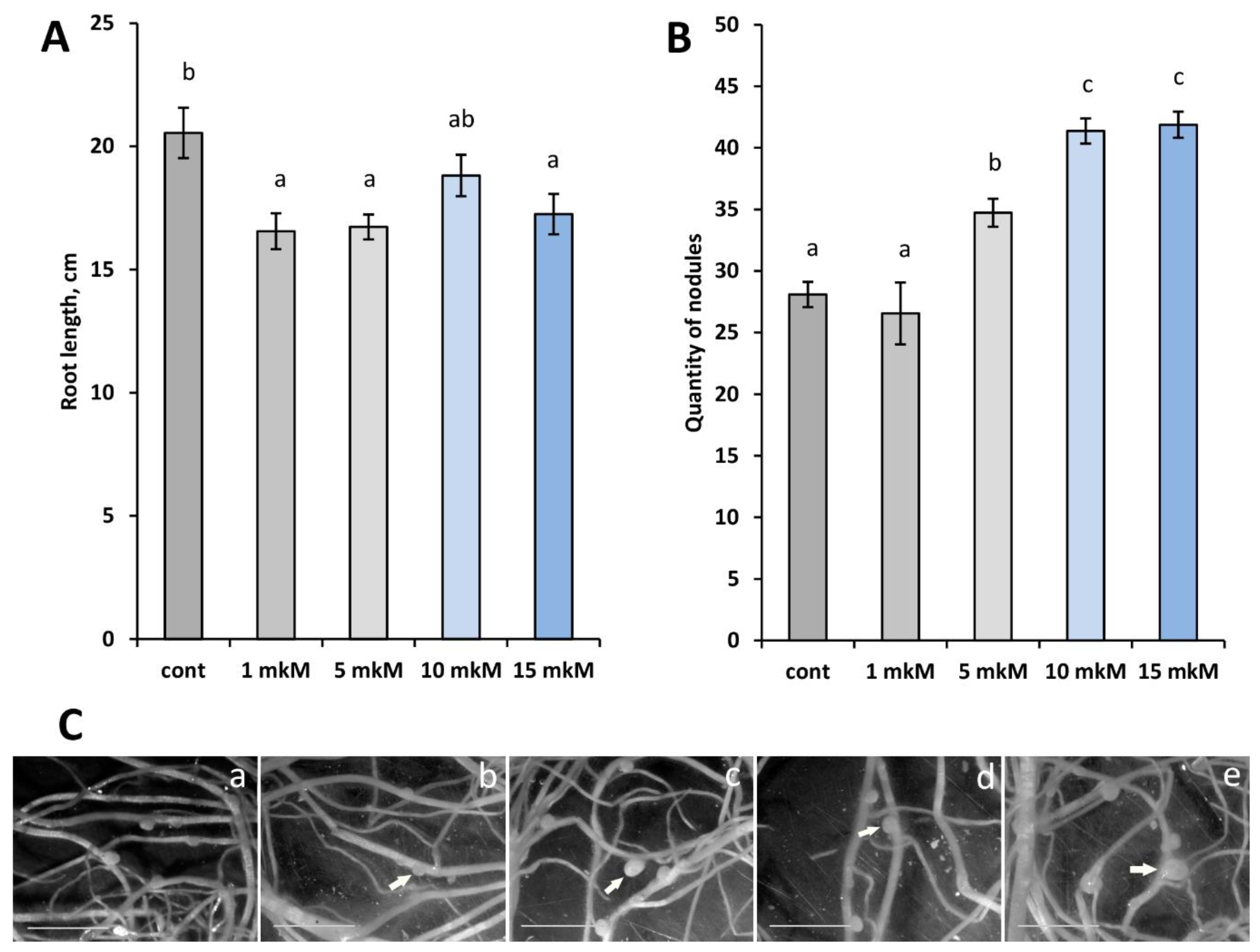
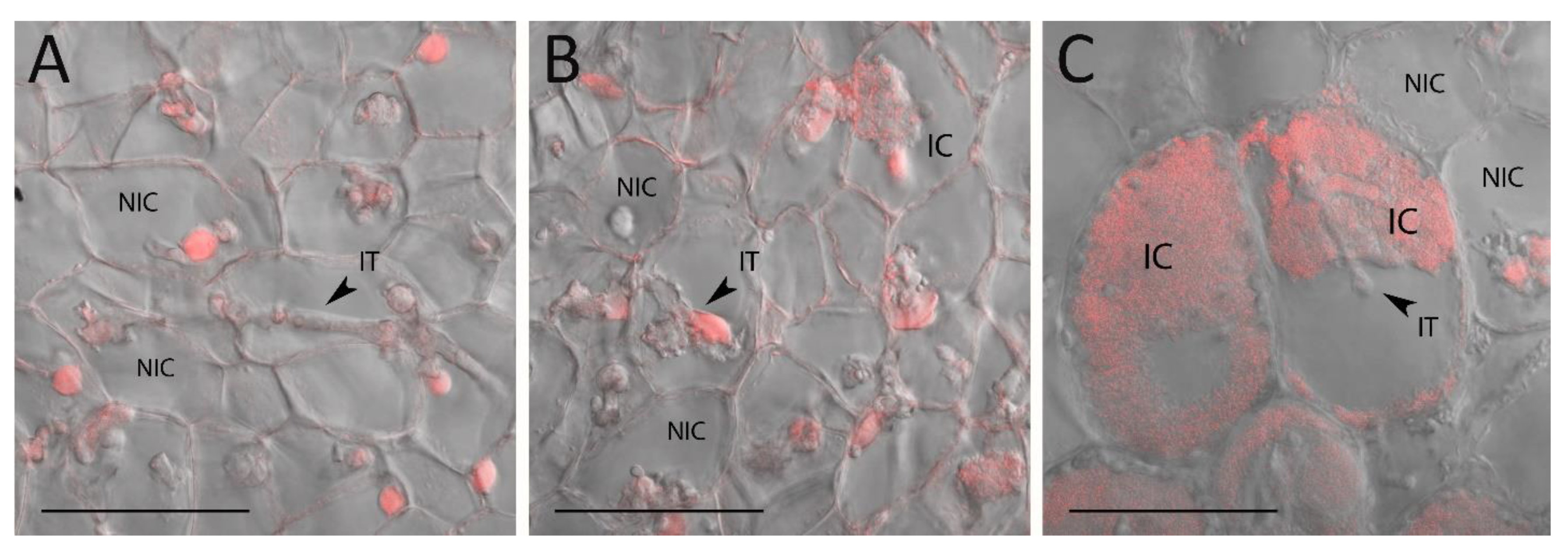


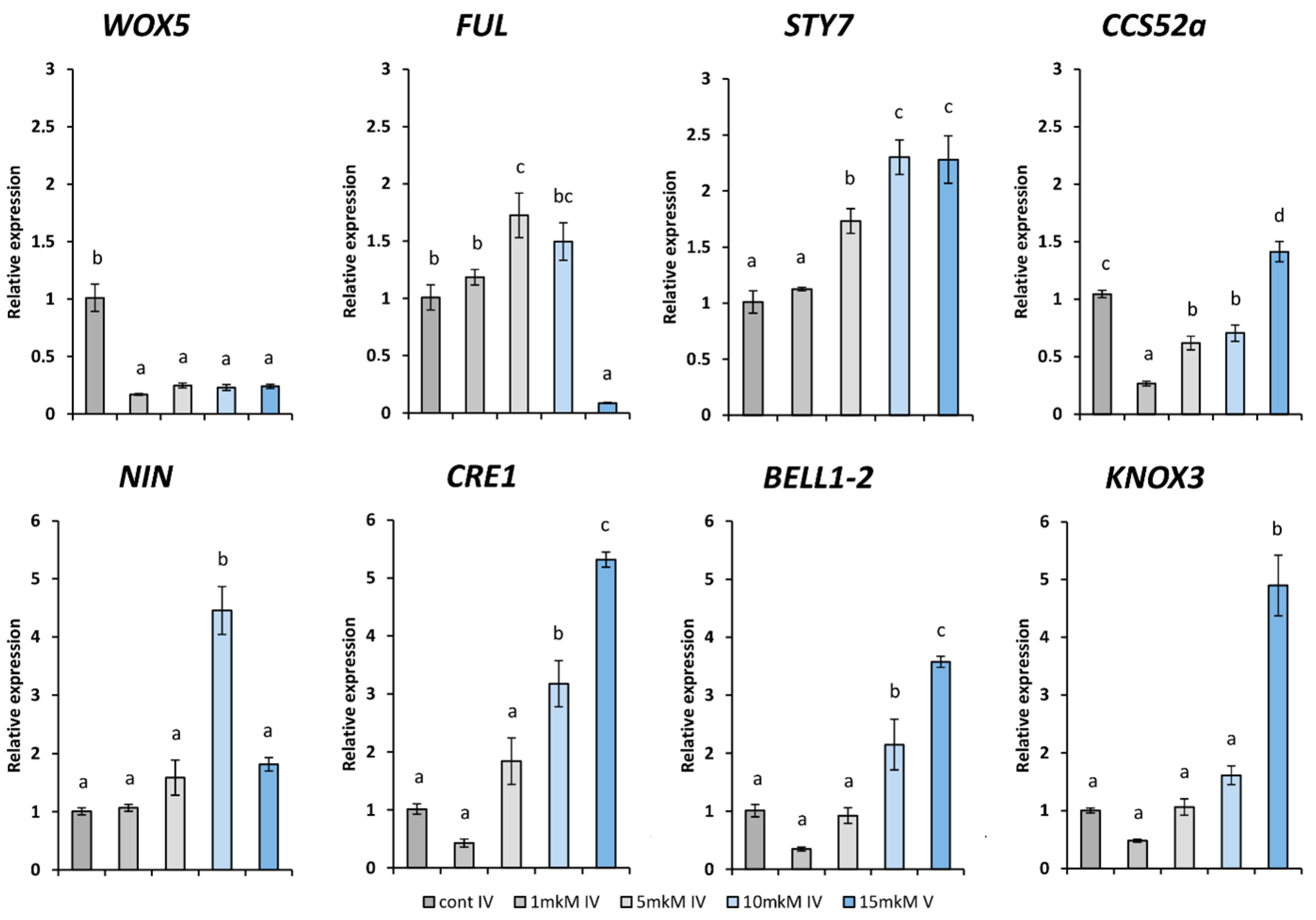
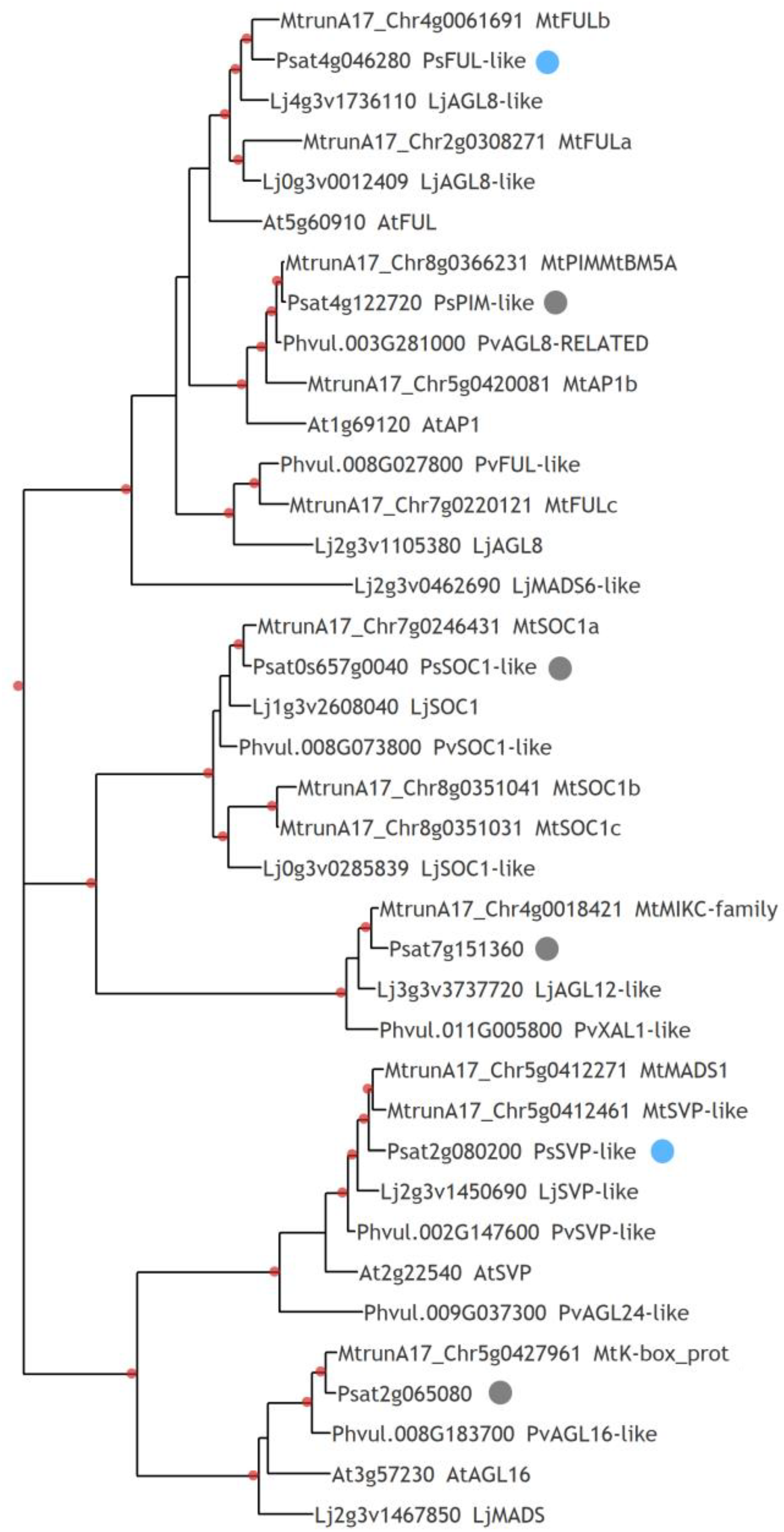
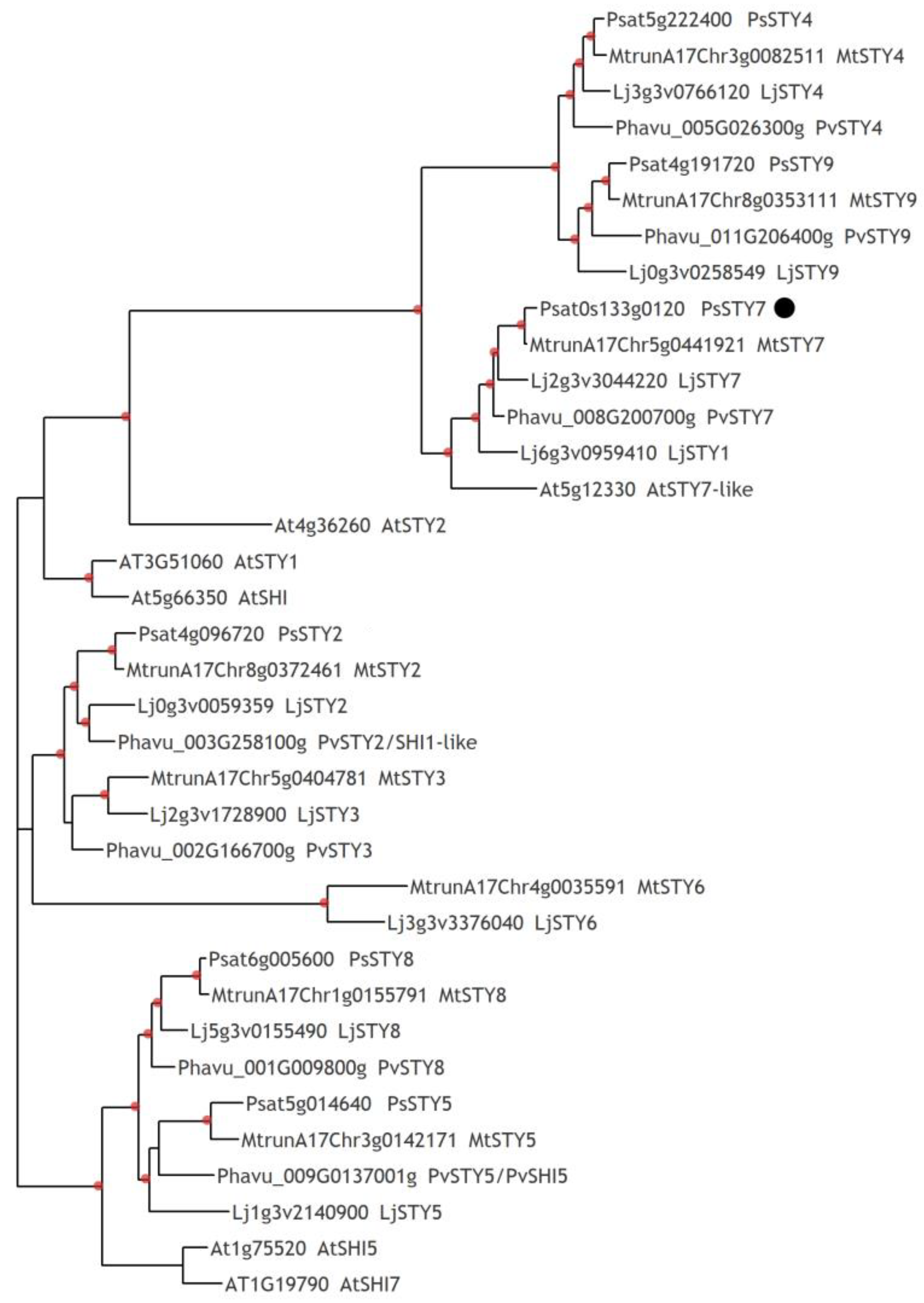
Disclaimer/Publisher’s Note: The statements, opinions and data contained in all publications are solely those of the individual author(s) and contributor(s) and not of MDPI and/or the editor(s). MDPI and/or the editor(s) disclaim responsibility for any injury to people or property resulting from any ideas, methods, instructions or products referred to in the content. |
© 2023 by the authors. Licensee MDPI, Basel, Switzerland. This article is an open access article distributed under the terms and conditions of the Creative Commons Attribution (CC BY) license (https://creativecommons.org/licenses/by/4.0/).
Share and Cite
Kantsurova, E.S.; Ivanova, A.N.; Kozyulina, P.Y.; Dolgikh, E.A. Exogenously Applied Cytokinin Altered the Bacterial Release and Subsequent Stages of Nodule Development in Pea Ipd3/Cyclops Mutant. Plants 2023, 12, 657. https://doi.org/10.3390/plants12030657
Kantsurova ES, Ivanova AN, Kozyulina PY, Dolgikh EA. Exogenously Applied Cytokinin Altered the Bacterial Release and Subsequent Stages of Nodule Development in Pea Ipd3/Cyclops Mutant. Plants. 2023; 12(3):657. https://doi.org/10.3390/plants12030657
Chicago/Turabian StyleKantsurova (Rudaya), Elizaveta S., Alexandra N. Ivanova, Polina Y. Kozyulina, and Elena A. Dolgikh. 2023. "Exogenously Applied Cytokinin Altered the Bacterial Release and Subsequent Stages of Nodule Development in Pea Ipd3/Cyclops Mutant" Plants 12, no. 3: 657. https://doi.org/10.3390/plants12030657
APA StyleKantsurova, E. S., Ivanova, A. N., Kozyulina, P. Y., & Dolgikh, E. A. (2023). Exogenously Applied Cytokinin Altered the Bacterial Release and Subsequent Stages of Nodule Development in Pea Ipd3/Cyclops Mutant. Plants, 12(3), 657. https://doi.org/10.3390/plants12030657







